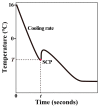Variations of Supercooling Capacity in Intertidal Gastropods
- PMID: 36830511
- PMCID: PMC9952152
- DOI: 10.3390/ani13040724
Variations of Supercooling Capacity in Intertidal Gastropods
Abstract
Winter low-temperature confines species distribution. Intertidal gastropods are distributed from tropical to polar zones, facing variable intensities and durations of low temperatures. They usually set their supercooling points (SCPs) at high subzero temperatures to stimulate freezing. However, the variations in SCP in intertidal gastropods at intraspecific and interspecific levels remain poorly understood. Here, we measured the body size, cooling rate, and SCP of nine intertidal gastropod species in China. These species were distributed in high or middle intertidal zone with different geographic distributions. The average SCPs (-4.27~-7.10 °C) and the coefficients of variation of SCP (22.6%~45.9%) were high in all species. At the intraspecific level, the supercooling capacity was positively correlated with the cooling rate. Interspecifically, the supercooling capacity was closely related to the cooling rate, and also to the species' geographical distribution. Northern high-shore species showed lower SCPs, while southern high-shore species had higher SCPs. There was no difference in SCP between widespread high- and mid-shore species. Our results indicated that the supercooling capability is potentially an adaptative response to the local winter temperatures, and the cooling rate is a factor in determining the difference in SCP at the intraspecific and interspecific levels.
Keywords: cooling rate; low temperature; molluscs; species distribution; supercooling point.
Conflict of interest statement
There are no conflict of interest.
Figures







Similar articles
-
Supercooling Points of Adult Dermacentor variabilis (Acari: Ixodidae) From a Population Near the Northern Distribution Limit.J Med Entomol. 2021 Mar 12;58(2):961-964. doi: 10.1093/jme/tjaa223. J Med Entomol. 2021. PMID: 33073293
-
The relationship between gut contents and supercooling capacity in hatchling painted turtles (Chrysemys picta).Comp Biochem Physiol A Mol Integr Physiol. 2006 May;144(1):98-104. doi: 10.1016/j.cbpa.2006.02.010. Epub 2006 Mar 6. Comp Biochem Physiol A Mol Integr Physiol. 2006. PMID: 16580240
-
Supercooling capacity and cold hardiness of band-winged grasshopper eggs (Orthoptera: Acrididae).J Insect Sci. 2014 Jan 1;14:289. doi: 10.1093/jisesa/ieu151. Print 2014. J Insect Sci. 2014. PMID: 25527594 Free PMC article.
-
Survival at low temperatures in insects: what is the ecological significance of the supercooling point?Cryo Letters. 2002 Jul-Aug;23(4):217-28. Cryo Letters. 2002. PMID: 12391482 Review.
-
Supercooling-Promoting (Anti-ice Nucleation) Substances.Adv Exp Med Biol. 2018;1081:289-320. doi: 10.1007/978-981-13-1244-1_16. Adv Exp Med Biol. 2018. PMID: 30288716 Review.
Cited by
-
Cold tolerance strategies of freshwater mussels across latitudes.Sci Rep. 2025 Jul 1;15(1):22232. doi: 10.1038/s41598-025-06450-7. Sci Rep. 2025. PMID: 40594982 Free PMC article.
References
-
- Helmuth B., Mieszkowska N., Moore P., Hawkins S.J. Living on the edge of two changing worlds: Forecasting the responses of rocky intertidal ecosystems to climate change. Annu. Rev. Ecol. Evol. Syst. 2006;37:373–404. doi: 10.1146/annurev.ecolsys.37.091305.110149. - DOI
-
- Mosbahi N., Pezy J.-P., Dauvin J.-C., Neifar L. Spatial and Temporal Structures of the Macrozoobenthos from the Intertidal Zone of the Kneiss Islands (Central Mediterranean Sea) Open J. Mar. Sci. 2016;06:223–237. doi: 10.4236/ojms.2016.62018. - DOI
-
- Paine R.T. A Note on Trophic Complexity and Community Stability. Am. Nat. 1969;103:91–93. doi: 10.1086/282586. - DOI
Grants and funding
LinkOut - more resources
Full Text Sources

